Agile software development is a gateway to top-tier software products, improved risk analysis, faster delivery, better cost management and flexibility, and satisfied customers. An Agile report survey by Digital.ai found that 86% of software development teams had adopted Agile in 2021 (compared to 37% in 2020) for faster delivery and lucrative outcomes. Statistics like these are validated by the fact that many giants like Apple, Microsoft, and Phillips use the Agile development model to increase the efficiency of their projects.
The approach leads to daily coordination meetings, an agile-driven workspace, monitors for planning, review meetings, product roadmaps, and multiple backlog management, improving business relationships and increasing IT project engagement for the business.
Agile has many roads that you can follow to implement a better development direction for your project, but knowing the process step by step will allow you to not miss out on any details that could disadvantage your project.
What is Agile Methodology?
Agile is a project management methodology that divides a project into multiple small projects to accelerate the process, improve collaboration and productivity, identify and remove potential risks, and deliver a quality product/service. It simplifies the planning, risk analysis, execution, delivery, and review process for the team by breaking the project into smaller segments (usually user stories). In short, agile development methodology can help prevent product failure/risks and reduce costs.
While traditional development methods have a timeline and specific approach that focuses on the project as one, Agile focuses on one thing at a time and turns that one thing into a small project with a team, deadline, review process, and feedback implementation.
For example, the traditional method would include a single timeline for building a marketplace website or app. It requires the developers to finish the whole app by that deadline to begin the testing and feedback process.
However, the Agile development methodology would break up the same marketplace website or app project and focus on a particular feature or UI/UX element like the Search and Filter feature or color combination for the core features.
Once the team completes such small projects, a meeting involving investors, stakeholders, designers, project managers, team leaders, and developers would take place for review and feedback implementation. Such meetings allow the team to improve the quality of every small element of the project, leading to a top-tier product once the project is complete.
It enables a development team to be as productive as they can be on every little element of the project rather than be somewhat or not at all productive during the whole project.
Applications of Agile
Implementing the Agile development approach into complex or basic projects enables you to direct its trajectory toward a lucrative result. Be that as it may, analyzing the essentiality of Agile in your project can help you implement the approach most effectively while avoiding the method that may not be suitable for your project.
For example, a recent survey of agile software delivery experts and influencers found that 37% of respondents prefer the Scaled Agile Framework (SAFe), while only 9% prefer Scrum@ Scale/Scrum of Scrums. Therefore, a strategic analysis of your project is the best way to incorporate the Agile methodology into your project/organization. It allows you to determine whether the approach is the right choice for your project.
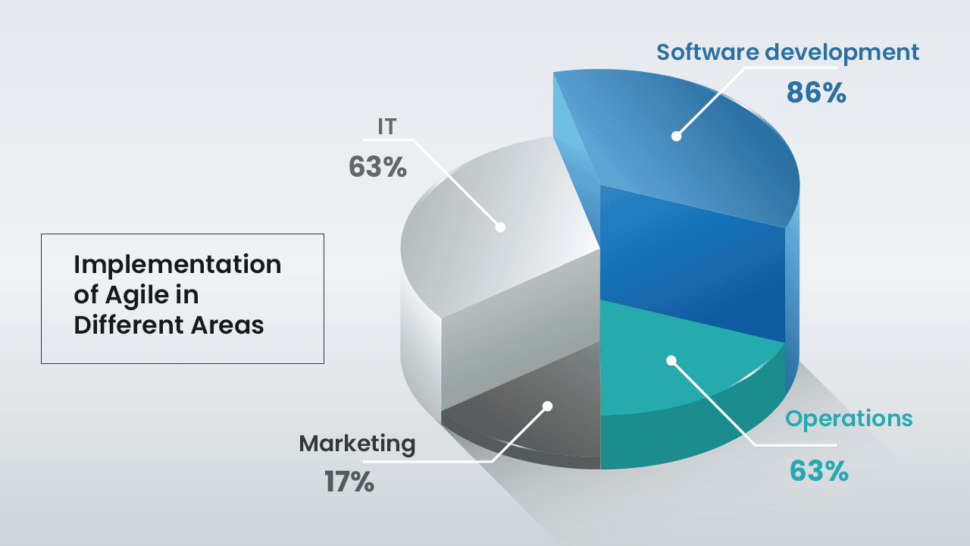
Below are some goals and tasks you can achieve with Agile implementation and decide how or whether it fits into your requirements:
- Accelerate product delivery and rapidly implement new changes.
- Ensure cost-effective solutions in new/rapid changes in products/services.
- Change the project scope and implement feedback as and when required.
- Increase regular interactions between developers, designers, stakeholders, and clients.
- Increase the project duration without damaging the budget to improve product quality.
- Allow the project to have incomplete elements that need reevaluation and move forward without affecting the quality of other phases.
- Increase the flexibility of the project when it comes to rapid deliverables.
- Find the ideal goal as the project progresses rather than determining a fixed one from the beginning.
- Include customers/end users and relevant third parties in the development process to implement a better perspective into every stage.
- Increase the quality and quantity of innovation in every aspect of the project.
- Increase/improve the communication and collaboration between all individuals involved in the project.
- Build a prototype to assess the potential and development direction for the final product.
- Get instant feedback for every product iteration, implement changes, and move on to the next stage.
- Implement user acceptance testing (UAT) in each stage (small or large deliverables) of the project.
If such goals favor your project, implementing the Agile development approach could bring the expected or better results.
Benefits of Agile Software Development
Since its introduction in 2001, the Agile development methodology has had some lasting and lucrative benefits for software projects and businesses that you can check out below.
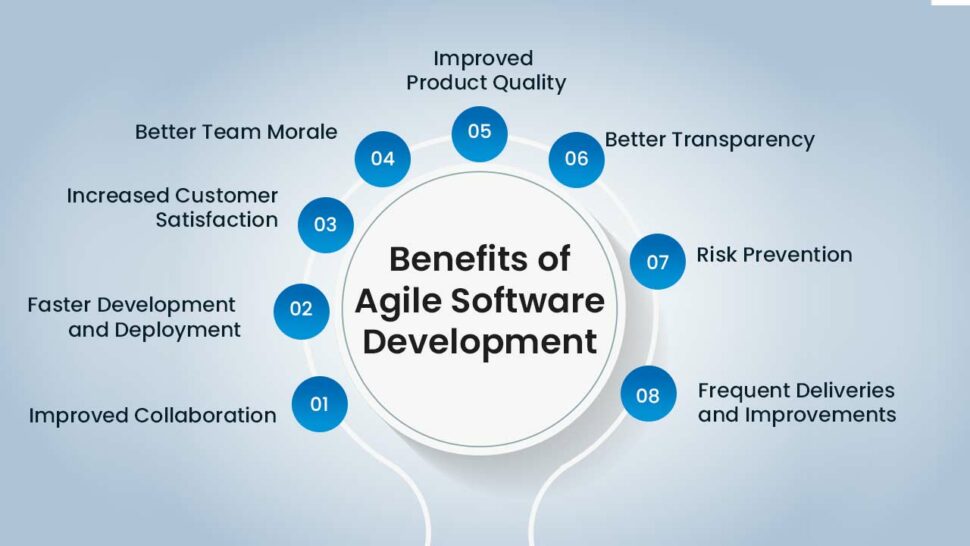
Improved Product Quality
Ensuring that the product quality meets expectations becomes a much easier task with rapid deliveries, feedback, UAT, and meetings with clients, investors, and stakeholders. Agile software development tools like Scrum make that easy with multiple management tools and effective strategies.
Agile development teams using the scrum framework in their project witness improvement in their product quality by 250%. It is made possible through frequent testing after every sprint cycle, which leads to the detection and removal of bugs, errors, and mistakes that could damage the quality. The constant involvement and interaction between developers, clients, investors, and stakeholders keep everyone on the same page about goals, avoiding unexpected results and leading to a superior quality product.
For example, implementing Agile in Financial Software Development would include sprints and iterations of feature development and UI/UX design. If a particular feature like Scan a QR Code is not working as intended after the sprint cycle, then the testing would identify the problem after each iteration. Getting feedback from clients, customers, investors, and stakeholders will help identify flaws or add new elements that could benefit the feature further.
Increased Customer Satisfaction
Organizations value customer satisfaction above all to survive in the business and outperform the competition. Due to user acceptance testing (UAT), review process with end users, and productive collaboration, Agile project management leads to a user-centric product/service that can make it happen.
49% of respondents in the Agile report survey stated that they measure the success of Agile through customer/user satisfaction. It is because implementing the Agile software development tools into every part of your project ensures that customer satisfaction becomes the primary USP of your product/service.
Faster Development and Deployment
Launching your products and services faster can give you the competitive advantage to get and retain loyal customers/users. The cost-effective iterations of divided project elements enable the team to remove any factors that could damage product quality, increase the cost, and delay the development process, which leads to accelerated development and deployment.
How does that work?
For example, if you are building a social media app through the traditional development process, the project would have particular goals, budgets, and deadlines to reach, after which the review and feedback process begins. If a team finds any errors and bugs in the social media app (like a Chat feature that crashes every time someone sends or receives a message), they have to work on it all over again, but after the whole development process is complete, which takes more money and time.
With Agile, such errors/bugs are identified right after the Chat feature development is complete since Agile includes iterations of sprints, followed by a collaborative review and feedback process after each sprint cycle. It significantly speeds up the development process and helps you deploy the final product in no time.
Improved Collaboration
A symbiotic collaboration is crucial for any development team to achieve the expected result toward the same goals while avoiding independent errors that could affect and slow down the whole process. Agile development teams are divided into smaller ones and assigned to smaller projects, which can simplify management and communication. As a result, encouraging and ensuring frequent communication becomes simple, and monitoring their work and the work of each other becomes a productive task with elements like code reviews that accelerate the process further.
Face-to-face communication, iterations, and daily meetings lead to increased productivity when communication in and between smaller teams is easy to manage and encourage.
For example, it is easier to manage the collaboration in a small team working on the code for a User Registration and Profile Feature in a P2P loan app than it is in a big team working on the same or multiple features at once with a single deadline. Such a P2P loan app project with an Agile approach would include a separate team or sprint cycle for User Registration and Profile feature development and another team or sprint cycle for the KYC verification feature.
Since they have pre-determined deadlines and review meetings in a sprint cycle, both and all such small teams can discuss their work, listen to team insights, discuss the work independently as a small team, and improve the overall quality. Such collaboration can turn a project into a product/service of top quality.
Better Transparency
As mentioned, the Agile approach includes multiple iterations through pre-planned sprints and weekly reviews. These review meetings help assess the work finished after each sprint cycle by involving developers, stakeholders, investors, and every other team member or individual involved in the project. Such a collaborative process makes every stage and element of the ongoing project clear to the team.
For example, if a feature in the healthcare Software development journey does not meet the client or end-user expectations, developers will quickly improve the product where necessary after the sprint cycle. Agile increases the transparency of the ongoing project for clients/stakeholders and ensures that everyone can easily monitor or improve the progress without slowing it down.
Risk Prevention
Every project with product/service issues, errors, mistakes, and strategy flaws can increase the cost and duration when identified after the development is complete. For example, if developers make coding errors when building a Place Order feature in your marketplace website, finding out about it after project completion could further delay the launch, which will only benefit your competitors.
Agile software development processes include code reviews that allow developers to monitor, identify, and deal with any coding errors right after it is complete. The same Agile development principles also involve a risk analysis to determine project feasibility and identify or help prepare for risks. It helps prevent outcomes that could prove financially disadvantageous for organizations.
Better Team Morale
A collaborative approach to every small project element in development and management saves everyone involved from an increased workload. The weekly review process also helps have a productive group conversation in the team that can bring everyone on the same page. It allows them to manage all aspects of the project and team members more effectively.
The frequent reviews help managers appreciate the work of developers and UI/UX designers in group meetings while reconfirming the feasibility of the project direction that the whole team is following, which can significantly improve team morale and increase productivity.
Frequent Deliveries and Improvements
The smaller project iterations through the Agile approach lead to frequent deliveries that can accelerate the review process. It is much easier for the team to demonstrate and review the finished elements of a product/service every 2, 3, or 4 weeks instead of doing it all at once after it is complete. Not only does it help review the project more carefully, but it also helps improve the product/service from a lens that identifies and helps remove all errors/mistakes.
For example, if you build a streaming service, it would be better to demonstrate and review the features like Play, Pause, Search, and Categories as the developers build them, ensuring the final iteration works perfectly and has no errors. It enables the team to identify their mistakes soon after they make them, deal with them, and prevent them long before the product/service is ready for deployment.
Such a process also leads to multiple improvements in every little aspect of the project, leading to a superior quality product/service after completion.
Disadvantages of Agile Software Development
Agile software development can lead to unexpected and disadvantageous outcomes without effective management and planning.
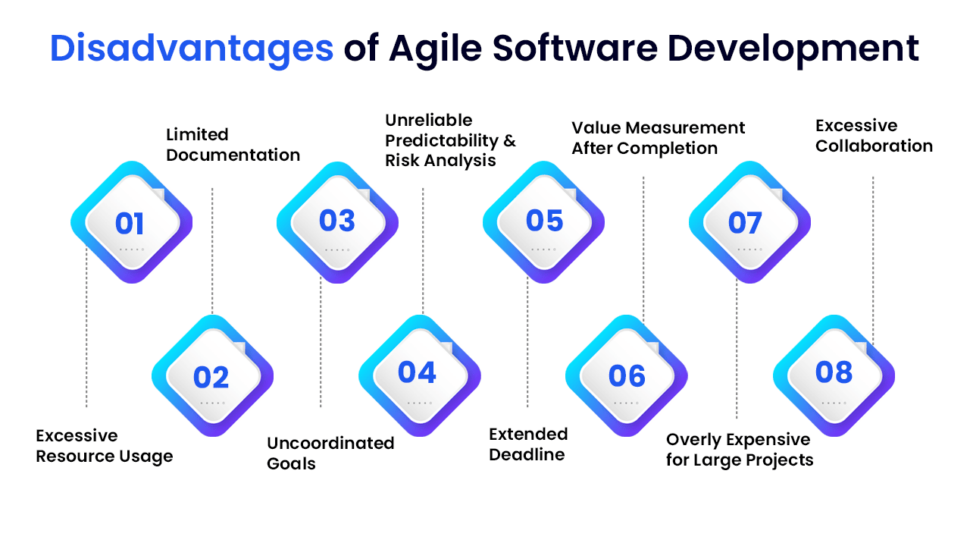
Excessive Resource Usage
Divided Project Iterations is the keyword in Agile software project management. You can and must repeat every project phase and improve it multiple times to ensure it delivers the expected quality. Such repetitive development can lead to excessive usage of resources available under the determined project budget. Without careful planning, risk analysis, and management, Agile would cost you more money and time than is available for your project.
Limited Documentation
With Agile software development, physical or digital documentation about the project is not the priority and is often the most delayed process. Agile focuses on responsive actions and improvements with every step instead of progress documentation, which is known to improve product quality.
Not documenting every element (like the spent budget, available budget, progress reports, and unexpected spending) leads to many risks with the budget and project goals. The team can easily monitor, improve, or change the process when every stage/progress is well-documented.
Uncoordinated Goals
In Agile-driven software development projects, you must divide your team into smaller ones according to requirements and sprints. Ensuring the goals of every team stay the same can be complicated as they all have somewhat similar but different responsibilities.
For example, developers may consider senior citizens as the target users when building a telemedicine app. However, QA engineers/testers may focus on old, middle-aged, and young target users when testing the app. It can significantly affect the evaluation of the application performance in terms of user interface and user experience. A constant discussion between every team is essential to ensure everyone works toward the same goal.
Unreliable Predictability and Risk Analysis
Predicting outcomes and managing risk analysis can become difficult with Agile as it relies on frequent customer feedback and weekly-based iterations. Initial customer feedback may direct the Agile development process in one direction, while the second may force the team to consider another strategy as customer feedback can change.
For example, a group of target users may say a particular chair is comfortable today and find the same chair uncomfortable in a week. Such a customer-driven process can make it nearly impossible to predict outcomes, identify or prevent risks, and build a product/service within the appropriate budget.
Extended Deadline
Since Agile delivers in sprints followed by a review process, user feedback, and change implementation iterations, the team never has a definitive deadline to commit to in order to ensure a quality product. It can extend the project timeline if various iterations are not up to the mark.
Value Measurement After Completion
Agile-driven software development projects include incremental deliveries, which involve new elements with every sprint cycle and as the project progresses. It complicates the identification of key performance indicators (KPIs) in your software, as it can change with every iteration. Measuring the value of your software according to target user needs is essential to create a product that can succeed.
Overly Expensive for Large Projects
Agile software development can be a short process or an extended project based on the quality you expect and need from your software. However, an over-extended development process for large projects (like an advanced marketplace website) can significantly increase the budget requirements since every small UI element and feature in such a website includes paid third-party tools, specific timelines, and expensive senior developers.
Excessive Collaboration
Planning team meetings every few weeks with reviews, customer feedback, and change recommendations can lead to overthinking by everyone involved in the project. It can lead to product elements (features/UI/UX design) that are not necessarily crucial for its success. Or mistakes that are avoidable when the developers/designers do not have to deal with frequent reviews of their work, followed by change recommendations, which can make anyone self-conscious about their work.
Agile Manifesto
Agile Manifesto is a document including 4 Agile values and 12 Agile development principles that guide software developers in correct and effective Agile implementation.
Importance of Agile Manifesto
As driving school lessons help you learn how to drive a car safely and get your license, the Agile Manifesto teaches you how to apply the Agile approach to projects correctly to ensure the success you expect. What difference does it make? Using Agile frameworks like Scrum and Kanban can be ineffective when you are unaware of all the factors that go into the Agile approach.
For example, not knowing or following the manifesto may lead to software developers, not including end users in the development/review process as expected in the Agile approach. The Manifesto is a simplified guide to Agile implementation in any software development project, making it easier for businesses to provide value through their digital solutions.
Four Values of the Agile Manifesto
The four values of the Agile Manifesto state the importance the developers have to give one process or factor over another to improve the quality of the outcome.
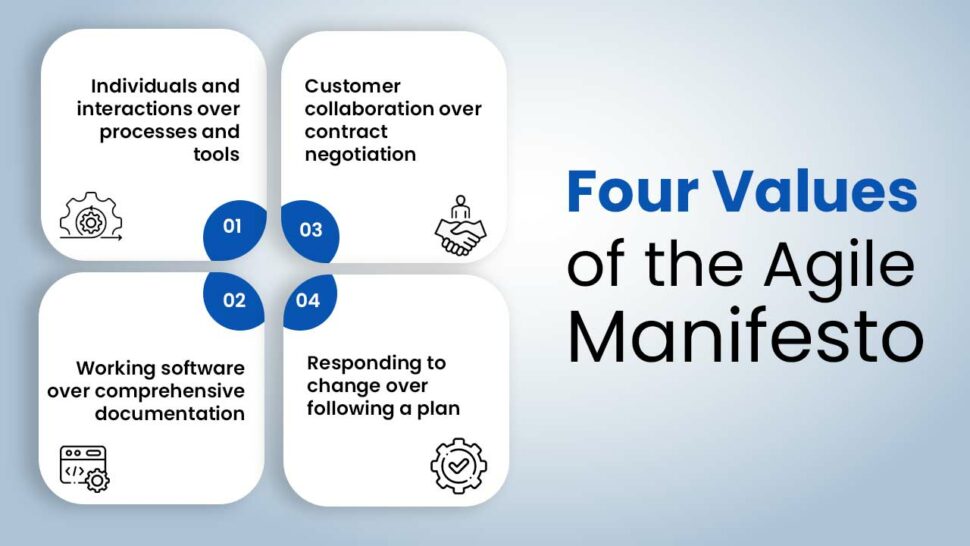
Individuals and interactions over processes and tools
Focusing on user needs and expectations through frequent communication is preferably more essential before planning the development process or using the best tools.
Working software over comprehensive documentation
Put more effort into the actual development of the software instead of documenting every progress and result (as and when it happens) to save valuable time and accelerate the process.
Customer collaboration over contract negotiation
Increase daily interaction and collaboration with target users/customers by including them in the process from beginning to end in order to meet their needs with the product.
Responding to change by following a plan
Make your project adaptable to any required changes through frequent and short iterations and a minimum viable product instead of sticking to a specific plan or direction.
The 12 Principles of the Agile Manifesto
Software developers must follow the 12 Agile development principles in the manifesto to ensure the effectiveness of the Agile approach in their projects.
1. Make it a priority to satisfy the customers with early and continuous delivery of quality software.
Meeting customer needs and expectations becomes easy when you focus on satisfying them through quick and continuous deliveries.
2. Make your project adaptable to change in every stage to ensure you build a user-centric software product.
Customer needs/expectations and the ability of your competitors to meet those needs can change within days. Being able to adapt to such changes during development gives your product a competitive advantage over others. The small and frequent iterations of the project should make that easier.
3. Deliver functional software weekly or monthly, but focus on weekly deliveries frequently.
Use sprints (Scrum framework) of 1 to 4 weeks to plan smaller iterations of the project and deliver working software every few weeks.
4. Developers/designers, target users, and stakeholders should work together every day.
You can keep everyone on the same page while increasing the productivity of the process by encouraging daily collaboration between the developers, designers, managers, clients stakeholders/investors, and target users.
5. Get a team filled with dedicated individuals, provide them with the tools/resources they need, and trust them to do their job.
– Creating a team of motivated developers and designers ensures your project has the right energy.
– Providing them with the tools/resources or workplace they prefer will ensure they have everything they need to make the project happen.
– Trusting them to do their job without even a hint of micromanagement will help ensure they are confident and more dedicated to their work.
6. Only face-to-face communication can prevent miscommunication and encourage better collaboration.
Face-to-face communication prevents miscommunication and increases healthy communication/collaboration during every meeting and the review process.
7. A working software determines the progress of your project.
If your software feature or UI element is not functional, ready, and meeting user needs at the end of every sprint cycle, there is no real progress in your project.
8. The right amount of effort and time by everyone involved leads to sustainable development.
Everyone included in the process (like developers, designers, investors, stakeholders, and the target users) must stick to the weekly sprint processes to avoid delays in delivery, leading to overtime work (by other team members) and burnout, which can reduce the productivity of the whole team.
9. Pay more attention to the technical work and design to increase productivity.
When you frequently look into the software coding work and UI/UX design, you identify elements or mistakes that need a change or a fix. It prevents a scenario where such changes and improvements happen later in the process, causing delays in other Agile development phases and costing more time/money.
10. Creative Simplicity is the key to success.
Meeting target user needs should be about being creatively simple with less to exceed the expectations of many. And not about advanced tools and additional effort.
11. Self-organizing teams dedicate themselves to the project goals.
Teams with the freedom to manage themselves and their work are better motivated to provide value to target users through a quality software product.
12. Plan intervals to find a better strategy that can increase effectiveness.
Taking a pause and evaluating the mistakes and progress helps create a better strategy and direction to increase the overall efficiency of the development process. It increases the engagement of everyone involved and boosts productivity.
Agile Frameworks
Agile software development includes multiple frameworks you can implement to increase the efficiency of your processes.
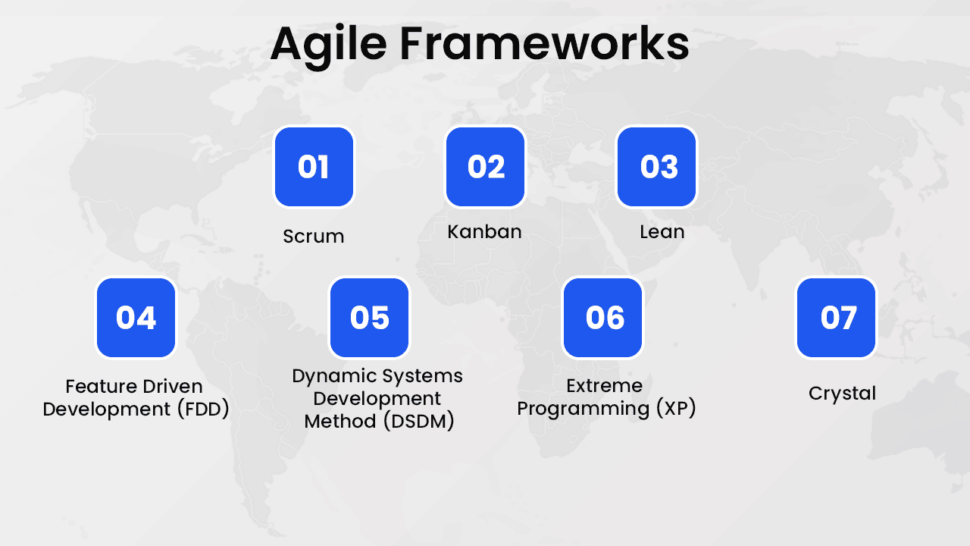
Scrum
Scrum framework is an iterative process involving sprints for the smaller parts of a divided project to improve its planning, development, management, and accelerated delivery. Scrum in software development includes a product owner, scrum master, and developers. It helps ensure value-based prioritization, collaborative learning, self-organizing, better teamwork, and increased transparency. 66% of respondents from an Agile survey said the Scrum framework is their preferred Agile development approach.
Kanban
Kanban is a visual framework that helps software developers implement the Agile approach to projects. This framework turns every process into a visual one through the Kanban board to identify and deal with flaws and improve communication and transparency through visual assistance. Visualized project management approach increases team transparency and makes it easy to monitor, understand, and follow the same project guidelines while identifying and removing flaws in the process.
Advantages of Kanban in the Agile development model include more visibility and efficiency, improved productivity, increased transparency, better management, and increased flexibility. A recent survey by Kanban University found that 87% of respondents find Kanban much more effective than other frameworks.
Learn
Much like Agile, Lean methodology in software development focuses on providing value to customers by ensuring the team has all the information, tools, and resources they need for continuous product improvement and preventing waste/unnecessary elements. Lower costs, improved predictability, increased transparency and efficiency, fewer to no bottlenecks, productive Agile software development processes, and improved team engagement are some benefits of the lean methodology.
Extreme Programming (XP)
Although it is not the most widely used Agile framework, Extreme Programming (XP) improves the quality of a software product by increasing target customer interaction and engagement in the process. It focuses on what has worked on customers before and what more they expect now in real-time to determine a development direction with predictable outcomes. It can include automated and manual testing, user acceptance testing, code reviews, and incremental Agile development cycles.
Example:
Ford Motor replaced the waterfall model (Used for four years with no valuable outcomes) with Extreme Programming to build their Vehicle Cost and Profit System Project (VCAPS). It led to automated tests, a 40% reduction in reported bugs, and 80% of the system functionality was complete within six months, an outcome the waterfall model could not help achieve in four years.
Feature Driven Development (FDD)
As the name suggests, FDD focuses on every feature of the software that would provide value to target users, leading to benefits like limited but productive team meetings, user-centric development, and transparent project scope.
The Feature-Driven Development (FDD) model is one of the best frameworks to choose for software development. It is an incremental and iterative approach focused on user-centric features. The model also motivates the prevention of miscommunication and coding errors, which are responsible for damaging the user experience of any software. It is helpful in large or long software development projects due to its user-centric approach toward feature development.
Dynamic Systems Development Method (DSDM)
Dynamic Systems Development Method (DSDM) is a framework that enables software teams to build and maintain software systems through a more disciplined and structured approach. It focuses on user needs, better project control/management, improved collaboration, timely deliveries, and a quality-driven development process. Widely recognized as an Agile scaling methodology, DSDM helps software developers improve the development and management process to ensure on-time product deliveries within the available budget.
Crystal
Crystal is an Agile framework primarily used for small or startup projects. It focuses on adaptability to change, the independent abilities of the team, and the uniqueness of the project. The framework allows the team to independently manage or prevent various obstacles in the Agile development process, ensuring a product quality that they determine to be the most effective and providing value to the target users.
This framework is about putting your trust in the team and their abilities and letting them create user-centric software without excessive monitoring or micromanagement. It allows a team to find their own unique way of developing a software product instead of following the simple software development methodologies or guidelines set by managers. Crystal framework leads to improved team morale and dedicated individuals since it gives them the creative freedom to build a quality product.
User Stories in Agile Software Development
In Agile software development, user stories are short and informal descriptions of user needs and expectations from your software. They are effective Agile software development tools that help determine project requirements by analyzing them from the perspective of end users. A user story explains how much value a software product provides to target users.
User story example:
As a ride-hailing app user, I want to call or text the assigned drivers before they reach my pickup address so that I can ask them which modes of payment they are willing to accept.
A user story is focused on the Who, What, and Why between your target users and the software product.
WHO
Research and determine the target end users that would be interested in or need your software/app.
WHAT
Find the common problem or need the target users have that your software/app can solve or meet.
WHY
Find out why the users have a particular problem or need and what they have to benefit from solving that problem or meeting those needs.
A well-researched and written user story is a goal for sprints that software developers can keep in mind as they continue developing.
Epics
An agile epic is one big story that is a collective representation of multiple user stories. While a user story is a small goal, an epic is the ultimate goal software developers accomplish by meeting those small user story goals.
For example, if your food delivery app project has user stories about Personalization, Set Location, and Search and Filter feature, then the Epic/goal for those stories would be to find happening and relevant restaurants within seconds.
Epics determine the duration and number of sprints a software development project needs by adding and removing user stories as and when necessary. A group of user stories is an epic, while a group of epics is a theme, which is another ultimate goal of your software development project. Software testing and customer feedback enable teams to create user-centric and effective epics.
The benefit of Epics is that they allow software developers to manage every element of the project according to user needs and feedback, which directs team productivity toward a more lucrative outcome.
Traditional Project Management vs. Agile
The waterfall model is the most traditional software project management method you can come across. It is a sequential and linear approach toward software development, leading to progress that takes place phase by phase. For example, if your Waterfall-driven project has ten development phases, you cannot work on the 2nd without completing the first and the 7th without the 6th. Management and control of the project through a well-planned process and a single goal become somewhat easy with the Waterfall model.
| Pros and Cons of the Waterfall Model | |
| Pros | Cons |
| Fewer Complications | Fixed Requirements |
| Predictable Process | Prone to Errors |
| Faster Delivery | Time-consuming Documentation |
| Easy Budget Management | No Real-time Feedback Implementation |
Pros of the Waterfall Model
Although not so popular among new or old developers, the waterfall method has benefits that are suitable for the requirements of some software development projects.
Fewer Complications
Managing a pre-planned process with specific budget and delivery dates can have fewer complications.
Predictable Process
Since every project phase is planned and determined with no room for sudden changes, the waterfall method is a predictable process, which may prove helpful for projects with tight budgets and deadlines.
Faster Delivery
In the Waterfall model, everyone knows what to do, when to do it, and when they have to finish without worrying about any mid-process changes, which can lead to faster delivery if you have a capable development team.
Easy Budget Management
Planning and managing the budget of a pre-planned project is less complicated.
Cons of Waterfall Model
The Waterfall model now seems ineffective to many organizations as frameworks like Agile and Lean simplify project planning and management while improving team productivity.
Fixed Requirements
The waterfall model has fixed goals, requirements, and project stages, which removes the adaptability-to-change element from a project, a necessary element in a competitive market with changing needs. It also does not allow the rework option in the project until the development is complete.
Prone to Errors
Since the Waterfall model allows product testing after the development is complete, the final software product often has errors and bugs.
Time-consuming Documentation
The method includes regular documentation of the progress and completed/pending tasks, which can take up a lot of time that the team could spend on product development instead.
No Real-time Feedback Implementation
Unlike Agile, traditional project management methods (like the Waterfall model) do not include the end user in the development process until after it is complete, which prevents the implementation of real-time user feedback in the process that can lead to a user-centric software product.
Difference Between Waterfall and Agile Software Development
The waterfall model follows a linear and sequential approach in project management, whereas Agile includes an incremental approach with multiple iterations backed by user stories and epics.
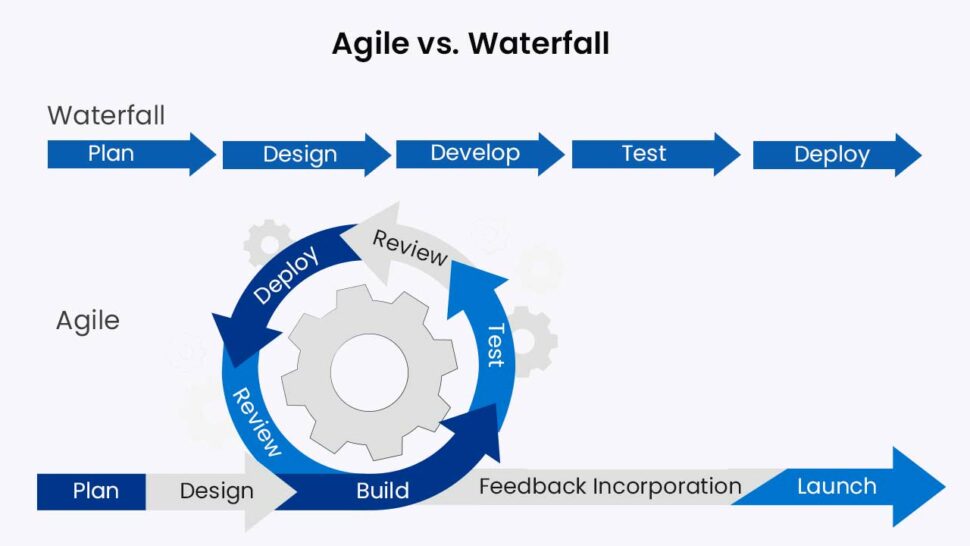
The rest of the differences are merely the consequences of choosing these software development methodologies.
Software Testing
Software testing is an integral part of the development to identify and deal with any bugs and issues that could damage its functionality and UI.
Waterfall
It does not include any software testing until after the project building phase is complete, which can lead to a product full of bugs, errors, and design issues.
Agile
It includes code reviews, automated testing, manual testing, and user acceptance testing (UAT) from the first sprint cycle till the last one in the project, ensuring that the software product is without any functionality or design issues once development is complete.
Adaptability to Change
The software industry can have new developments in the available technology and changes in the target user needs within days.
Waterfall
Once the process starts under the determined guidelines and tasks, incorporating new elements and changes in the project becomes impossible until after completion, which makes it difficult to meet changing user needs.
Agile
Agile development methodology has the advantage of incremental deliveries and iterations, making the project adaptable to any change required to improve the quality of the final product.
Complex Projects Compatibility
Every software development project has levels of complexity for features and design.
Waterfall
Due to its linear and sequential nature, the Waterfall method is only suitable for small projects or projects with basic requirements since many random changes can take it back to the first phase. Testing after completion, no sudden changes, and no real-time end-user feedback make it impossible and financially risky to use the model for large or complex projects.
Agile
Agile methodology is compatible with all types of software projects from multiple sectors. Its iterative approach and incremental deliveries make it the safest and most effective way to conduct simple, large, and complex development projects.
Cost-effective Flexibility
Making changes to the project stages mid-process can lead to expensive outcomes and time waste when the project is not a success.
Waterfall
Waterfall has a fixed strategy, timelines, and a budget, meaning if you make any changes to the process after it is complete, your project will cost more money than necessary.
Agile
Agile methodology is flexible and saves costs from beginning to end. The approach requires the development of an MVP product to get end-user feedback for further improvements.
Incorporating innovative changes in Agile-driven projects can be as easy and inexpensive as putting jelly on a peanut butter sandwich.
Transparency
Keeping everyone on the same page about the progress or setbacks in the project is essential to maintain the collaborative development approach to the project.
Waterfall
In the Waterfall methodology, only the project manager is entirely aware of the progress since the method does not include clients, stakeholders (for reviews), investors, target users, or frequent team meetings for reviews. It leads to a project where the team can lose sight of business goals and create a product that lacks the perspective of many creative individuals in its design.
Agile
It includes weekly meetings after the sprint cycle that involve stakeholders, clients, target users, and every other individual involved in the project, which ensures that everyone is working toward the same goal and is supportive of how the project is progressing. The involvement of target users implements a user-centric approach to any software development project.
Real-time Feedback and Improvements
If you are building a boat for the first time, would you test it on the water right after to understand its durability with people in it, or would you directly start selling it to target customers and risk a scenario where the boat could break and people could drown? The same concept applies to software development, putting your money and business at risk when the product fails the users.
Waterfall
The waterfall model includes fixed and mapped-out development phases, not including target user involvement or testing until after the completion. It removes the benefits real-time feedback and improvement can bring to a software development project.
Agile
Agile includes frequent and real-time involvement of target users in epics, user stories, sprints, and product testing. It enables the team to create a user-centric software product with no functionality or design issues.
| Difference Between Waterfall and Agile Software Development | ||
| Factors | Waterfall | Agile |
| Software Testing | After Project Completion | During and After Development |
| Adaptability to Change | No | Yes |
| Complex Projects Compatibility | Not suitable | Suitable and Recommended |
| Transparency | No | Highly Transparent Process |
| Real-time Feedback and Improvements | No | Yes |
Agile in Software Development
In the Digital.ai survey, 86% of company professionals said they use Agile for software development. It is because every process and stage is followed by a requirement analysis in the Agile software development life cycle. It makes the process highly flexible and adaptable to change in the ever-changing software industry.
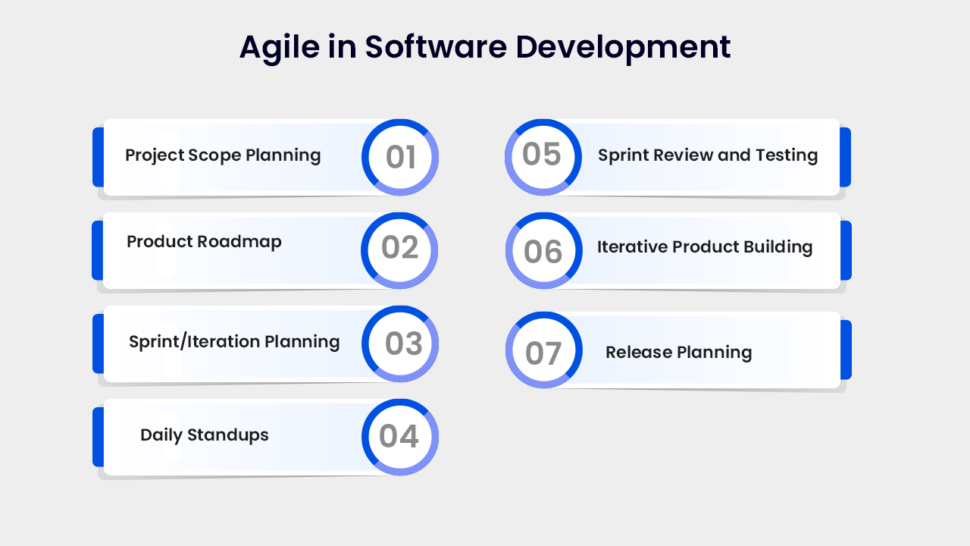
An agile development approach can also lead to a reduced budget, fewer or no risks, superior quality software products, better transparency, predictable deliveries, and self-managing project control.
Project Scope Planning
The first step in the Agile software development life cycle is identifying and analyzing the end goals of the projects, how much value it brings the business/organization, and how you can make it happen. It is where you determine the project scope and divide it into smaller parts with epics, user stories, user journey maps, and sprints. Every small project/sprint has a flexible goal, meaning there can be no fixed scope for projects in Agile to leave room for new elements and better strategies. Everything is always adaptable to change to ensure the project leads to a user-centric outcome.
Project scope planning enables the Agile-driven software development company to assign individuals to sprints while making independent project goals clear to everyone through epics and user stories. It is also when you figure out the best way the team can carry out the development project while adding new elements to it mid-process. Such analysis helps determine the resources, time, budget, and new project goals as and when required.
Product Roadmap
A product roadmap is a visual tool that describes the goals, development direction, tools, and various strategies that allow the creation of the software product and help determine its progress. It is also where you can create a product backlog that includes all the features, design, and new change requirements of the project. A product roadmap allows the team to stay on the same path to reach a single goal and collectively monitor and discuss the various strategies involved in the software development project. 58% of respondents in an Agile survey said they use product roadmapping to better plan and manage Agile-driven projects.
Sprint/Iteration Planning
As the name suggests, sprint planning in Agile is about creating sprints/iterations for every independent element in the project, determining its scope, and figuring out how you can make every sprint work. It is when you plan and analyze the number of team members, sprint review meetings, product backlogs, and task ownership.
83% of respondents from a survey (of 4,182 agile software delivery experts) stated that their organization conducts sprint planning. In this process, you verbally and visually communicate the tasks every team member is responsible for and must complete in a sprint cycle. They must also leave room for new elements and errors/bug solutions according to feedback from target users, stakeholders, clients, and other creative individuals from the team.
Daily Standups
Daily standups are regular meetings of 10 to 15 minutes in scrum teams to monitor and analyze the progress of every team member in order to make changes in the stages and improve the product. 87% of Agile software delivery experts confirmed that their organization uses daily standups in scrum development.
The meetings are to briefly discuss what every team member did the day before and what the members will do today to track the progress and identify any problems that need attention and solutions.
Iterative Product Building
The team can start the software development process once the sprint planning is complete and approved. Developers and UI/UX designers must deliver the first iterations of their sprint goal and ensure that the iteration of the product is ready for launch at the end of the sprint cycle for review.
Sprint Review and Testing
The review process begins after each sprint cycle, including a meeting with clients, stakeholders, developers/designers, target users, and managers. It is when the team can decide whether rework is required in the sprint results and extend or increase the number of sprints if necessary.
It helps everyone understand how a particular software system works and whether it can use improvements. The review process must include automated, manual, and user acceptance testing with QA engineers to analyze the functionality of the delivered system from the perspective of developers and end-users, allowing you to make user-centric changes and improve the product.
Release Planning
After the sprint review and approval, you have to release the built software features and UI/UX elements at the end of the sprint cycle (which can be between 3 to 4 weeks). Each sprint cycle must have a completion and release date for every software element.
It is basically how an average Agile-driven software development project works. Yours may require the same, different, or more steps according to your project requirements.
Conclusion
Agile should always be the first consideration and choice when choosing a software project management method. It offers speed in development, improves team morale, and leads to better productivity, reduced costs, and better quality products.
In comparison, traditional project management is slow and not adaptable to the changing requirements of the software industry. It is where the Agile methodology shines brightly due to its incremental and iterative approach.
Planning an Agile-driven software development project leads to various lucrative results if you plan it strategically and according to the flexible requirements of your project.
Frequently Asked Questions
Agile is a methodology that you can apply to your software development project to better control and manage its outcome to your benefit. Unlike traditional methods, Agile allows a development team to build, review, and release a software product in parts. It helps ensure that the final product is without errors/bugs and delivers superior quality.
Agile improves collaboration, project flexibility, productivity, team morale, and product quality through its iterative and incremental approach, all of which can give a software product a competitive advantage in the market. It includes stakeholders, clients, and target users of the software in the development to get a better perspective and lead the process toward a user-centric direction.
Unlike traditional methodologies like Waterfall which have a sequential and fixed strategy, Agile has an iterative and incremental approach that divides a project into multiple small ones (sprints) to improve productivity, flexibility, and testing by incorporating real-time feedback from target users in the process. In short, it significantly increases the chances of success for any software developed with its approach and frameworks.
In a recent survey by Digital.ai, 64% of respondents stated that they adopted Agile into their process to accelerate software delivery, 47% did it to improve productivity, and 42% of them adopted it to improve product quality.
Agile improves the project flexibility, transparency, quality of work, team collaboration, and team morale while accelerating the process with reduced costs. Developing a product with Agile helps identify its potential, weaknesses, and financial risks, which helps assess the project better and leads to a development strategy designed to result in a quality product that can outperform the competition.















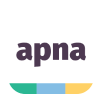
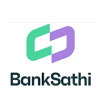
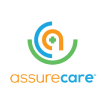
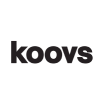
.png)
.png)
.png)



Leave a Comment